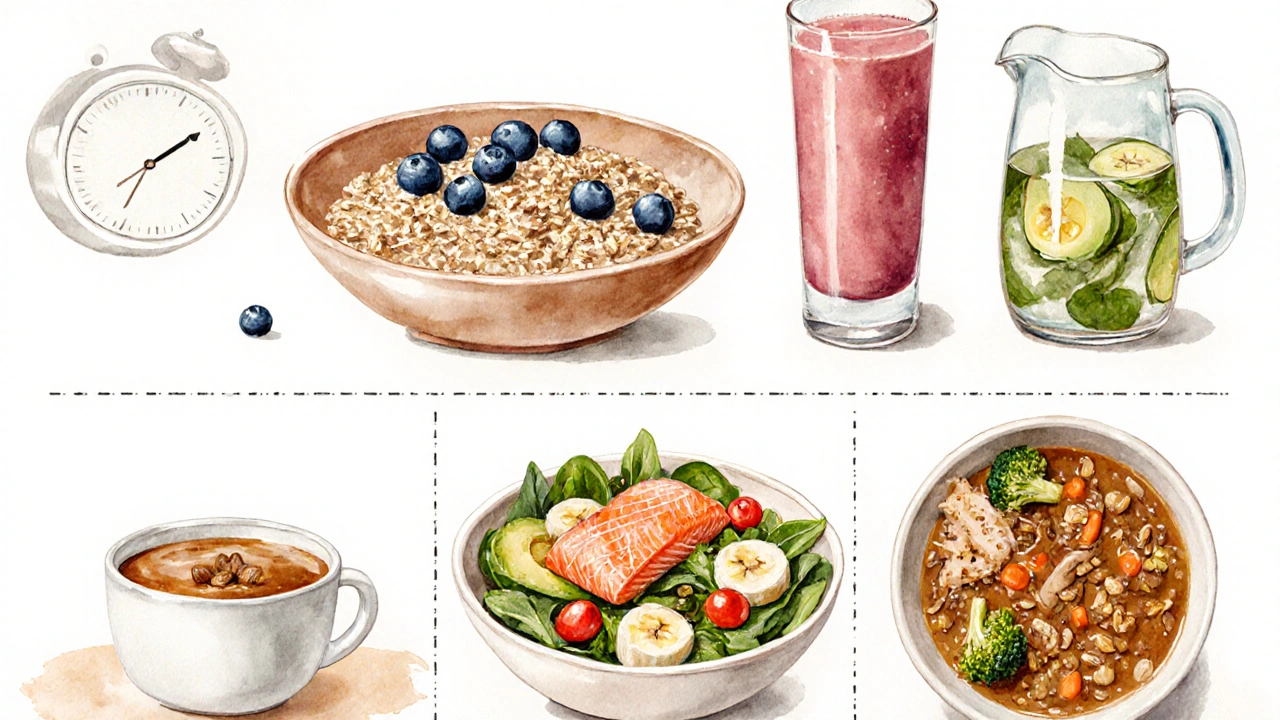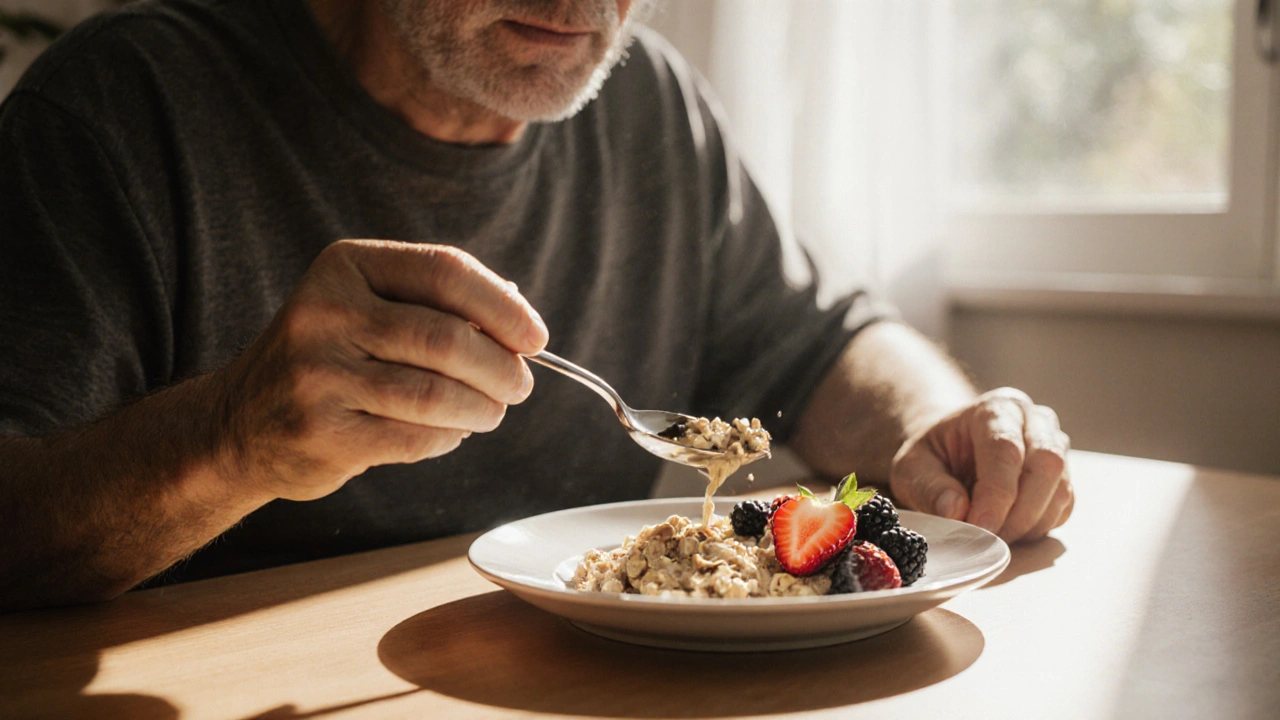Levodopa-Protein Timing Calculator
How Your Diet Affects Dyskinesia
Levodopa absorption is competed by protein-rich foods. Timing protein intake away from medication can reduce dyskinesia severity. This tool helps you calculate your optimal protein windows based on your medication schedule.
Your Optimal Protein Timing
Why this matters: Protein competes with levodopa for absorption. By timing protein away from medication, you can reduce motor fluctuations and dyskinesia severity.
Dyskinesia is a neurological condition that causes involuntary, erratic muscle movements, often appearing as a side effect of long‑term levodopa therapy in Parkinson’s disease. Many patients wonder whether the foods on their plate can calm these movements or make them worse. The short answer: yes, what you eat can influence the severity of dyskinesia, but it’s not a magic cure. Below you’ll find the science, practical tips, and a handy checklist to help you experiment with a diet that supports smoother motor control.
Why Nutrition Matters for Dyskinesia
The brain relies on a delicate balance of neurotransmitters, especially dopamine. Dopamine deficiency underlies the motor symptoms of Parkinson’s disease, while fluctuations in dopamine levels after taking Levodopa can trigger dyskinesia. Food can affect both the absorption of levodopa and the overall oxidative stress that damages dopaminergic neurons.
Key mechanisms include:
- Protein competition - high‑protein meals can slow levodopa’s entry into the bloodstream.
- Antioxidant protection - oxidative stress accelerates neuronal loss; antioxidants help mitigate damage.
- Gut microbiome modulation - certain gut bacteria influence drug metabolism and inflammation.
Core Nutrients That Influence Motor Fluctuations
Below is a quick snapshot of nutrients that have the strongest evidence for affecting dyskinesia.
| Nutrition | Potential Effect on Dyskinesia | Typical Recommended Amount |
|---|---|---|
| Omega‑3 fatty acids | Anti‑inflammatory; may improve motor control | 1-2g EPA/DHA per day (e.g., 2‑3 salmon servings) |
| Antioxidants (vitamins C, E, polyphenols) | Reduce oxidative stress on dopaminergic neurons | Fruit & veg ≥5 servings/day; supplement 400IU vitaminE if needed |
| VitaminD | Supports muscle function; low levels linked to worse motor symptoms | 800-1000IU daily, higher if deficient (blood test‑guided) |
| Protein (timed) | High‑protein meals can delay levodopa absorption | Spread 15‑20g protein across meals; keep a protein‑free window 30‑60min before levodopa |
| Fiber & pre‑biotics | Feeds beneficial gut microbes, may improve drug metabolism | 25‑30g daily (whole grains, legumes, berries) |

How Levodopa Interacts With Food
Levodopa is absorbed in the small intestine via the same transporters that carry large neutral amino acids (LNAAs) like phenylalanine, tyrosine, and tryptophan. When you eat a protein‑rich meal, those amino acids compete with levodopa, slowing its uptake and creating peaks and troughs that fuel dyskinesia.
Practical tricks:
- Take levodopa on an empty stomach whenever possible.
- Reserve the majority of protein for dinner, after your morning levodopa dose.
- Use protein‑free nutrition shakes (often based on carbohydrates) in the morning to meet calorie needs without the competition.
Sample Day of Eating for a Balanced Dyskinesia‑Friendly Diet
Below is a realistic menu that fits the nutrient guidelines above. Adjust portions to your caloric needs.
- Breakfast (30min before levodopa): Oatmeal made with almond milk, topped with blueberries, a tablespoon of ground flaxseed (omega‑3 source), and a drizzle of honey.
- Mid‑morning snack: A protein‑free smoothie - banana, mango, spinach, and a scoop of plant‑based carbohydrate powder.
- Lunch (after levodopa window): Grilled salmon salad with mixed greens, cherry tomatoes, avocado, and a vinaigrette made from olive oil (rich in polyphenols). Sprinkle pumpkin seeds for a modest protein boost.
- Afternoon snack: Greek yogurt (if tolerated) with a handful of walnuts and a sprinkle of cinnamon.
- Dinner (protein‑rich, later evening): Quinoa bowl with roasted chicken breast, steamed broccoli, carrots, and a side of lentil soup. Finish with a glass of fortified orange juice (VitaminD + calcium).
Notice that the biggest protein load is at dinner, leaving the morning relatively low‑protein to avoid interference with levodopa.
Key Takeaways
- Nutrition can modulate levodopa absorption and oxidative stress, both of which affect dyskinesia severity.
- Prioritize omega‑3 fatty acids, antioxidants, vitaminD, and fiber while timing protein away from levodopa doses.
- Use a protein‑free window of 30‑60minutes before and after medication to smooth out drug peaks.
- Track your symptoms alongside food logs; small adjustments often yield noticeable improvements.

Practical Checklist for Managing Dyskinesia with Diet
- ☑️ Keep a daily food and medication diary for at least two weeks.
- ☑️ Schedule a protein‑free breakfast window before taking levodopa.
- ☑️ Include at least two servings of fatty fish or plant‑based omega‑3 sources weekly.
- ☑️ Aim for five colorful fruit/veg servings daily for antioxidants.
- ☑️ Ensure 800‑1000IU vitaminD daily (blood‑test guided).
- ☑️ Add 25‑30g fiber each day through whole grains, legumes, and berries.
Frequently Asked Questions
Can a low‑protein diet cure dyskinesia?
No. Reducing protein can improve levodopa absorption, which may lessen the intensity of dyskinesia, but it won’t eliminate the condition. Long‑term health also requires adequate protein, so the goal is timing, not elimination.
Are there specific foods that trigger dyskinesia?
Highly processed meats, excessive saturated fats, and very high‑protein meals taken close to levodopa doses can increase motor fluctuations. Spicy foods or caffeine don’t directly cause dyskinesia, but they may worsen tremor in some individuals.
How long does it take to see dietary effects on dyskinesia?
Most people notice changes within 2‑4 weeks of consistent meal timing and nutrient adjustments. Keep a symptom diary to pinpoint which tweaks make the biggest difference.
Should I take supplements instead of eating the foods?
Whole foods provide a synergy of nutrients that supplements can’t fully replicate. However, if you have a proven deficiency (e.g., low vitaminD), a targeted supplement is advisable under medical guidance.
Is the dyskinesia diet safe for everyone with Parkinson’s?
The principles-balanced nutrients, timed protein, antioxidant‑rich foods-are generally safe. Individual needs vary, especially for those with swallowing difficulties, diabetes, or weight‑loss concerns, so tailor the plan with a dietitian.
Next Steps If You Want Personalized Guidance
1. Book an appointment with a registered dietitian who has experience in neuro‑degenerative conditions.
2. Bring your medication schedule and a week’s worth of food logs.
3. Work together to fine‑tune protein timing, adjust micronutrient doses, and set realistic goals for symptom tracking.
Remember, diet is a powerful ally, but it works best alongside optimal medication management and regular neurologist follow‑ups.


All Comments
Edwin Pennock October 13, 2025
Look, timing protein around levodopa isn’t some new fad-it’s backed by basic pharmacology. When you stuff a big steak before your pill, the amino acids jam the transporters and you get those wiggles later. Splitting your protein into smaller bites after the 30‑minute window can smooth out the peaks. I’ve seen patients cut their dyskinesia by half just by moving dinner to the evening.
John McGuire October 14, 2025
🔥 Absolutely! Your point hits the nail on the head-small changes can make a massive difference! 🎉 Keep the protein light in the morning and let those omega‑3s shine later. 🌊💪
newsscribbles kunle October 15, 2025
Our great nation’s traditional meals are often protein‑heavy, and that’s why many of our elders suffer from uncontrolled dyskinesia. The Western “quick fix” of protein‑free windows is just a marketing ploy, but the science still stands: amino acids compete with levodopa. Adjust your diet, and you respect both your health and cultural heritage.
Bernard Williams October 17, 2025
Good point about cultural foods. In practice, you can preserve those beloved dishes by simply shifting them to later in the day, after your medication has been absorbed. For example, enjoy a hearty bean stew at dinner while keeping breakfast light on protein. Adding a daily dose of salmon or flaxseed gives you the omega‑3s without compromising the meal’s spirit.
Michelle Morrison October 18, 2025
Protein timing is just one piece of the puzzle.
harold dixon October 19, 2025
When considering the gut microbiome, it’s worth noting that fiber‑rich foods can modulate how levodopa is metabolized. Introducing a variety of prebiotic sources-like chicory root or oats-may improve drug consistency over time. It’s a subtle tweak, but the cumulative effect can be meaningful for motor control.
Darrin Taylor October 20, 2025
Even if you trust the mainstream narrative, you have to ask who profits from pushing expensive supplements over simple dietary changes. The truth is hidden in plain sight-most patients do fine with whole foods.
Anthony MEMENTO October 21, 2025
People often overlook that a balanced diet isn’t just about macro ratios; micronutrients like vitamin D and antioxidants play a crucial role in neuronal health. Skipping these can worsen dyskinesia even if protein timing is perfect.
aishwarya venu October 22, 2025
Exactly the point, and adding berries or leafy greens daily brings those antioxidants in a tasty way not a pill.
Nicole Koshen October 23, 2025
From a grammatical perspective, the guidelines in the article are clear: “keep a protein‑free window 30‑60 minutes before levodopa.” Following that rule consistently can reduce variability in symptom reporting. Also, logging meals alongside medication times helps identify personal patterns.
Ed Norton October 25, 2025
Sounds solid. I’ll start a log tomorrow.
Karen Misakyan October 26, 2025
It is incumbent upon us, as custodians of our health, to recognize that the interplay between pharmacokinetics and nutrition is not merely anecdotal but grounded in rigorous empirical investigation. The elucidation of amino acid competition for the L‑type neutral amino acid transporter underscores the necessity of strategic dietary scheduling. Consequently, adherence to a protein‑free interval preceding levodopa administration emerges as a non‑trivial determinant of therapeutic efficacy.
Amy Robbins October 27, 2025
Oh sure, because we all have the time to become nutritionists on top of our meds schedule-how convenient for the health industry.
Jessica Haggard October 28, 2025
Let’s celebrate the diversity of foods that can fit into these guidelines-think of Mediterranean salads, tropical fruits, and spices that add flavor without extra protein. Embracing cultural variety makes the diet sustainable and enjoyable for everyone.
Jenae Bauer October 29, 2025
When you look at the whole picture of dyskinesia management, the diet narrative feels like a convenient distraction from deeper systemic issues. The pharmaceutical companies love to promote a simple protein‑timing chart while they keep the prices of levodopa soaring. If you dig a little deeper, you’ll find that most of the “research” cited comes from studies funded by the very manufacturers whose pills you swallow. Meanwhile, the ancient wisdom of whole‑food cultures is brushed aside as “non‑evidence‑based.” Yet, centuries of culinary tradition know how to balance nutrients without the need for costly supplements. It’s not that omega‑3s or vitamin D aren’t helpful-they certainly are-but framing them as miracle cures is a marketing ploy. The real question is why the medical establishment isn’t more vocal about the socioeconomic barriers that prevent patients from accessing fresh fish or fortified dairy. Instead, you’re handed a list of “buy these items” that many can’t afford. The internet is flooded with influencers who tout their “personal protocols” while ignoring the broader context of food deserts. If we stop looking for quick fixes and start demanding policy changes, perhaps the burden of dyskinesia could be lifted in a more meaningful way. So, while I’ll follow the protein‑free window advice, I won’t stop questioning who benefits most from the hype. The neuro‑degenerative community deserves transparent data, not half‑baked charts that promise miracles. We should also recognize that stress and sleep quality interact with diet, complicating any single‑factor solution. A holistic approach that includes physical therapy, mental health support, and community resources will likely yield better outcomes. Until then, the protein‑timing tool remains a useful, albeit limited, piece of a much larger puzzle.